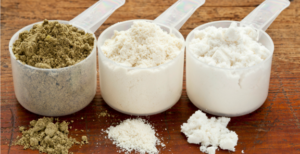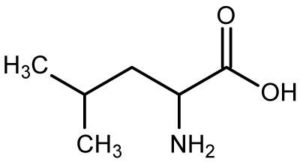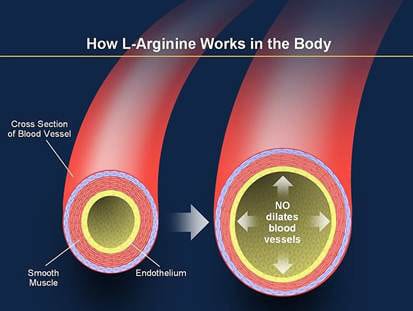This is a topic so large it could take stacks of text books (and it does!) and many semesters in college and years of research afterward, so an exhaustive review is both beyond the scope of this article and my brain!
There’s a few key areas however I plan to address in this article people will find helpful to making smart decisions the over hyped ads for protein, amino acids, and peptides don’t cover. For the most part, I recommend whole protein sources, such as whey, eggs, lean meats, fish etc. in terms of dietary protein* intakes, but some individual amino acids can be of benefit in specific applications. Those applications may be sports performance related, general health, or medical, but I’m getting ahead of myself.
Back In The Day…
Back in the day when I was taking my first nutrition courses and reading what research existed – right after the Pleistocene era – the mantra of nutrition was that digested  proteins were broken down into individual amino acids during digestion and absorbed, and that was that. As with virtually all overly simplified models generated from the early research examining human nutrition and physiology, it was wrong. To this day however, there are still those who believe it, but I digress. However, most know that ingested proteins are broken down primarily into small peptides and individual amino acids. The fact is, to this day, human digestion, absorption, and utilization of nutrients we ingest is still being elucidated with more discoveries being made than most people realize or appreciate. It’s amazing to me however the number of people – some educated enough in the sciences to know better – who think digestion, absorption, and utilization of the food we eat can be summarized as “it get’s dumped into the acid in your stomach, then absorbed via voodoo, the end.” Human digestion, absorption, and utilization of the nutrients we ingest, is an incredibly complex process, that as previously mentioned, still being elucidated. If you want to get a glimpse of how complex, the Encyclopedia Britannica site has a nice write up on that, and remember: digestion, absorption, and utilization of protein is but one very small aspect of it.
proteins were broken down into individual amino acids during digestion and absorbed, and that was that. As with virtually all overly simplified models generated from the early research examining human nutrition and physiology, it was wrong. To this day however, there are still those who believe it, but I digress. However, most know that ingested proteins are broken down primarily into small peptides and individual amino acids. The fact is, to this day, human digestion, absorption, and utilization of nutrients we ingest is still being elucidated with more discoveries being made than most people realize or appreciate. It’s amazing to me however the number of people – some educated enough in the sciences to know better – who think digestion, absorption, and utilization of the food we eat can be summarized as “it get’s dumped into the acid in your stomach, then absorbed via voodoo, the end.” Human digestion, absorption, and utilization of the nutrients we ingest, is an incredibly complex process, that as previously mentioned, still being elucidated. If you want to get a glimpse of how complex, the Encyclopedia Britannica site has a nice write up on that, and remember: digestion, absorption, and utilization of protein is but one very small aspect of it.
As mentioned previously, there are benefits and potentially unique effects to using individual amino acids, but studies indicate peptides are better absorbed and or utilized than individual amino acids. What that suggests is, even if the goal is to derive benefits from a singe amino acid (e.g., Leucine, Glutamine, etc.), it’s likely best to get it in peptide form. For example, instead of taking L-leucine alone as the free amino acid, to increase intakes of L-leucine, ingesting a leucine rich peptide is likely to be the superior approach. The science and understanding of the value of peptides in human nutrition, be it for health, performance, increased muscle mass, etc., is an evolving area of research yielding useful findings, and still in it’s early stages in fact. Because this is such a wide-open and extensive topic, I’m going to stay focused on a few key issues, such as the value of using individual amino acids or “free” amino acids vs. peptides even if the goal is to increase levels of a specific amino acid.
Free Amino Acid vs. Peptide Absorption and Utilization
 Studies find that diets fed to animals with identical amino acid composition, but fed as either free amino acids or as whey derived peptides, finds peptides have a greater nutritive value than free amino acids and greater tendency toward production of lean body mass. Additional human studies find the same effect, although not all studies concur in humans. The protein efficiency ration (P.E.R) is superior with peptides over whole proteins or free amino acids (FAA), and as alluded to above, digestion of whole proteins in humans produces mostly peptides for absorption and possible utilization vs. FAA.** Why are peptides more easily absorbed over FAA? Some amino acids have relatively low solubility for starters. As pointed out in part one of this series, solubility is essential and often rate limiting to digestion, absorption, and perhaps utilization of various nutrients we ingest:
Studies find that diets fed to animals with identical amino acid composition, but fed as either free amino acids or as whey derived peptides, finds peptides have a greater nutritive value than free amino acids and greater tendency toward production of lean body mass. Additional human studies find the same effect, although not all studies concur in humans. The protein efficiency ration (P.E.R) is superior with peptides over whole proteins or free amino acids (FAA), and as alluded to above, digestion of whole proteins in humans produces mostly peptides for absorption and possible utilization vs. FAA.** Why are peptides more easily absorbed over FAA? Some amino acids have relatively low solubility for starters. As pointed out in part one of this series, solubility is essential and often rate limiting to digestion, absorption, and perhaps utilization of various nutrients we ingest:
“It’s well established that compounds with poor solubility are poorly absorbed and have poor bioavailability. Compounds must be solubilized by the body before they can be absorbed. It’s accurate to say that solubilization, absorption, and metabolism are three key steps that modulate oral bioavailability of an ingested compound. In many cases, there’s a direct relationship to the solubility of the compounds or nutrient and it’s bioavailability.”
Other possible reasons why FAA are not as readily absorbed and utilized compared to peptides may be an interference with amino acid transporters, and the tendency of FAA to be oxidized by the liver, the different availability to gut flora of peptides vs. FAA, and differences in osmolarity between peptides and FAA which can impact gastric emptying and nutrient utilization. However, the reiterate, although the data is strongly supportive of the conclusions I’m making in this section, it’s far from conclusive and research is ongoing.
What of hydrolysates?
“Pre digested” proteins or hydrolysates yield peptides of varying lengths and appear to have some unique effects and advantages to whole “native” proteins or FAA alone. However, a major limitation of the differences between native proteins and their hydrolysates is that all hydrolysis does not yield the same hydrolysate end- product. That is to say, the degree of hydrolysis varies considerably between products yielding relatively large protein fragments down to di and tri peptides and combinations there of.
Unfortunately, the degree of hydrolysis is rarely reported in studies much less on product labels, leaving both those reading studies and buying products essentially in the dark. “On paper” hydrolysates should be of value, but the complete lack of standardization in both the research and end product sold to consumers makes them difficult to recommend at this time. Of course, if one is attempting to increase their intake of specific amino acid, hydrolysates are not the right choice for that goal regardless as they will supply the amino acid profile of the hydrolyzed protein vs. a specific amino acid.
Specific Peptide Products.
 Science focused companies have developed promising peptide technology. For example, Glanbia Nutritionals has developed a unique method of developing peptides that are rich in a given amino acid. Because L-Leucine is getting so much attention in the literature and sports nutrition community, *** I’ll focus on their Leucine peptide. The technology is called PepForm® and is already being added to various formulas on the market and can be identified by looking for the PepForm® logo on product labeling. The product yields a soluble and highly bioavailable peptide rich in a specific amino acid (in this case Leucine) and preliminary results with the PepForm® Leucine peptide product have been very encouraging; testing both PER values in animals as well as absorption characteristics in human volunteers.****
Science focused companies have developed promising peptide technology. For example, Glanbia Nutritionals has developed a unique method of developing peptides that are rich in a given amino acid. Because L-Leucine is getting so much attention in the literature and sports nutrition community, *** I’ll focus on their Leucine peptide. The technology is called PepForm® and is already being added to various formulas on the market and can be identified by looking for the PepForm® logo on product labeling. The product yields a soluble and highly bioavailable peptide rich in a specific amino acid (in this case Leucine) and preliminary results with the PepForm® Leucine peptide product have been very encouraging; testing both PER values in animals as well as absorption characteristics in human volunteers.****
Typical of the supplement industry, some companies who have identified the obvious benefits of peptides rich in Leucine – or other amino acids – simply responded by invented marketing terms and using buzz words like “micro enhanced delivery techno functional peptide delivery system” to lead consumers to assume there’s legit peptide technology in their products when they don’t… Such is the reality of the supplement industry, so per usual, consumers need to read labels and do a little digging on their own to see what’s got legit peptide tech behind it and what’s marketing mumbo jumbo.
Conclusion
The reader should understand I have attempted to distill down an extensive amount of technical information while doing my level best to be accurate in the “take home” recommendations and conclusions. Whole protein sources should make up the majority of dietary protein intake, hydrolysates show great promise but don’t appear ready for “prime time” and if one is attempting to increase their intake of a specific amino acid, peptide form appears the superior choice, even if the goal is to increase the intake of a specific amino acid. Some additional info on new technologies I’m looking at for improved absorption and bioavailability can be found HERE if interested in some visuals.
Additional Comments:
* = Why? Because whole protein sources deliver many nutrients beyond just protein or amino acids and should make up the majority of protein intake in any well rounded nutrition plan.
** = How is the PER figured? The PER is based on the weight gain of a test subject divided by its intake of a particular protein during the test period done with growing animals. The PER is one commonly used method for evaluating the quality of protein sources, but there are other methods, such a biological value (BV), net protein utilization (NPU) and the more recent PDCAAS. None are perfect, all have their potential drawbacks, nor reflect a 1:1 relationship to their score and how much muscle a person may gain from them, etc. As a rule, protein sources with higher scores PER/BV/NPU scored tend to be the more “complete” proteins, and or better choices for active people looking to gain or retain muscle, but that’s beyond the scope of this article and a topic of for a future article.
*** = The amino acid Leucine is getting a great deal of attention recently and rightly so. Leucine appears the most important amino acid of the in BCAA’s and is an essential nutritional anabolic driver. Leucine, acts as an essential signaling molecule in the mTOR cascade and a critical amino acid for increasing skeletal muscle protein synthesis as well suppressing muscle protein degradation. That’s what we call in science a “win win”! 😉
**** = As tested in animals vs. an equal amount of free form L-leucine, PepForm® was found to have lead to increased lean body mass when compared to matched free form L-Leucine in the diet of rats. In a group of human volunteers, PepForm lead to serum leucine levels known to trigger protein synthesis in humans, but these results have not been published in the peer reviewed literature to date.
SOURCES:
Protein Digestion in Human Intestine as Reflected in Luminal, Mucosal, and Plasma Amino Acid Concentrations after Meals. J Clin Invest. Jul 1973; 52(7): 1586–1594.
Food-derived bioactive peptides influence gut function. Int J Sport Nutr Exerc Metab. 2007 Aug;17 Suppl:S5-22.
Protein hydrolysate vs free amino acid-based diets on the nutritional recovery of the starved rat. Eur J Nutr. 2000 Dec;39(6):237-43.
Effect of whey proteins, their oligopeptide hydrolysates and free amino acid mixtures on growth and nitrogen retention in fed and starved rats. JPEN J Parenter Enteral Nutr. 1989 Jul-Aug;13(4):382-6.
Protein v. enzymic protein hydrolysates. Nitrogen utilization in starved rats. Br J Nutr. 1995 Jan;73(1):65-71.
Rates of absorption by rat intestine of pancreatic hydrolysates of proteins and their corresponding amino acid mixtures. Clin Sci. 1971 Nov;41(5):409-17.
Relative nutritional value of whole protein, Hydrolysed protein And free amino acids in Man. Gut,1985, 26,694-699
Effect of protein/essential amino acids and resistance training on skeletal muscle hypertrophy: A case for whey protein. Nutrition & Metabolism 2010, 7:51
Postprandial oxidative losses of free and protein-bound amino acids in the diet: interactions and adaptation. J Anim Physiol Anim Nutr (Berl). 2009 Aug;93(4):431-8.
Comparison of oral feeding of peptide and amino acid meals to normal human subjects. Gut. 1979 Apr;20(4):291-9
Will Brink is the owner of the Brinkzone Blog. Will has over 30 years experience as a respected author, columnist and consultant, to the supplement, fitness, bodybuilding, and weight loss industry and has been extensively published. Will graduated from Harvard University with a concentration in the natural sciences, and is a consultant to major supplement, dairy, and pharmaceutical companies.
His often ground breaking articles can be found in publications such as Lets Live, Muscle Media 2000, MuscleMag International, The Life Extension Magazine, Muscle n Fitness, Inside Karate, Exercise For Men Only, Body International, Power, Oxygen, Penthouse, Women’s World and The Townsend Letter For Doctors.
He’s also been published in peer reviewed journals.
Will is the author of the popular e-books, both accompanied by private members forum access , Bodybuilding Revealed & Fat Loss Revealed.
You can also buy Will’s other books on Amazon, Apple iBook, and Barnes and Noble.





Is L-Lucine Preform Peptide available for sale. Finding no marketing outlet..
jeff
I don’t believe it’s being sold as a stand alone product but added to various formulas to boost leucine content in a highly bio available form. It’s not inexpensive technology.
Will, I’m looking for companies who use Glanbia/PepForm in their products. I’ve searched on BB.com, and I keep getting BSN, but when I go to BSN’s website, there’s no mention of any connection to Glanbia/PepForm. I love following your blog since there’s so much truthful information, but how do I get these products ingested into my own body? Thanks again for all the info.
Top of my head PES select does utilize it.. good protein too
I mean PES SELECT protein
Google search should turn up some or perhaps contact Glanbia directly for a list of companies. I’ll see what I can dig up.
Very informative article.Thanks
Glad you found it useful 🙂
Gidday, easy to follow, great article. What’s your take on MAPS/SON Amino’s.
what is the difference between peptides and micro amino acids.
Hi Will, Just posting here since a search for “amino acids” just led here. Recently there has been an uptick in products marketed on social media as combinations of free amino acids, such as “Perfect Amino” and “Optimal Amino”. They claim to have ten times the utilization and benefit of whey protein. You are the whey expert, so I thought I’d ask what you think about these alternate products.